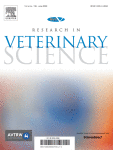View Item
- xmlui.general.dspace_homeCentros Regionales y EEAsCentro Regional Santa FeEEA RafaelaArtículos científicosxmlui.ArtifactBrowser.ItemViewer.trail
- DSpace Home
- Centros Regionales y EEAs
- Centro Regional Santa Fe
- EEA Rafaela
- Artículos científicos
- View Item
Resistance of the cattle tick Rhipicephalus (Boophilus) microplus to ivermectin in Argentina
Abstract
Resistance to ivermectin in populations of the cattle tick Rhipicephalus microplus in Argentina was diagnosed in this work. The in vitro larval immersion test (LIT) was used to determine quantitatively the levels of resistance to ivermectin in different populations of R. microplus. Additionally, field trials to control natural infestations of R. microplus on cattle with a commercial formulation of ivermectin 3.15% were carried and jointly analyzed with
[ver mas...]
Resistance to ivermectin in populations of the cattle tick Rhipicephalus microplus in Argentina was diagnosed in this work. The in vitro larval immersion test (LIT) was used to determine quantitatively the levels of resistance to ivermectin in different populations of R. microplus. Additionally, field trials to control natural infestations of R. microplus on cattle with a commercial formulation of ivermectin 3.15% were carried and jointly analyzed with the in vitro assays. The phenotypic response of the populations analyzed was not uniform. Five of them were classified as susceptible, four populations as resistant, and one in the category “incipient resistance”. Regarding the field trials, the therapeutic efficacy in a population classified with LIT as susceptible achieved values higher than 94% two weeks after treatment, and no reproductively viable females were observed after the second day post-treatment. Conversely, the values of efficacy percentage in a population (named as “San Martín”) classified with LIT in the category “incipient resistance” never exceeded the 70.8%, and engorged females were collected in practically all counts. The population “San Martín” was classified in the category “incipient resistant” with LIT analysis, but the field trial unambiguously shows that this tick population is resistant. The comparison of the results obtained with LIT in vitro assays and through field trials shows that biased estimations of resistance levels may occur when resistance ratios (RR) values are ≤2, and additional field efficacy trials could be needed to know with precision the status of the tick populations evaluated.
[Cerrar]

Author
Torrents, Jorgelina;
Sarli, Macarena;
Rossner, Maria Victoria;
Toffaletti, Jose Rodolfo;
Morel, Nicolas;
Martinez, Norberto Claudio;
Webster, Anelise;
Mangold, Atilio Jose;
Guglielmone, Alberto;
Nava, Santiago;
Fuente
Research in Veterinary Science 132 : 332-337 (October 2020)
Date
2020
Editorial
Elsevier
ISSN
0034-5288
Formato
pdf
Tipo de documento
artículo
Palabras Claves
Derechos de acceso
Restringido
 Excepto donde se diga explicitamente, este item se publica bajo la siguiente descripción: Creative Commons Attribution-NonCommercial-ShareAlike 2.5 Unported (CC BY-NC-SA 2.5)
Excepto donde se diga explicitamente, este item se publica bajo la siguiente descripción: Creative Commons Attribution-NonCommercial-ShareAlike 2.5 Unported (CC BY-NC-SA 2.5)

